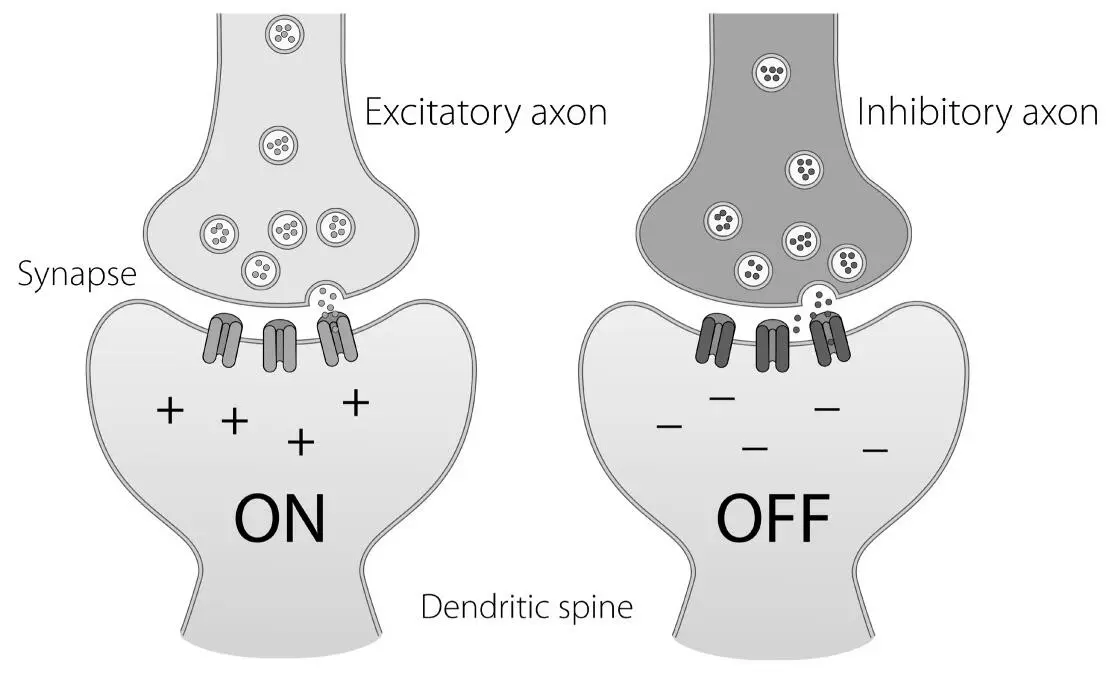When we see the color red, smell a rose, move a muscle, or remember someone’s name, action potentials are happening.
FIGURE 6. Anatomy of Neuron, Axon, Neurotransmitter, Synapse, Dendrite, and Myelin:Signals between cells flow in one direction, from an axon to a dendritic spine, through a synapse. Axons with myelin coating transmit signals faster than those without. At the synapse, a transfer of neurotransmitter molecules binds to the synaptic receptor on the spine.
If you think of each neuron’s cell body as a point in a relay, there must be an incoming and an outgoing signal. Once the outgoing signal reaches the axonal bouton, or end point, it sets off a reaction causing the bouton to release packages of chemical messengers, called neurotransmitters. The point of contact between two neurons is called a synapse, and is actually a space no more than two-millionths of an inch wide. The synapse is truly where the action takes place in the brain. The signal heads down the neuron through the axon to the synapse and is then released as a chemical message. Like liquid keys, these neurotransmitters cross the synapse and lock onto the neuron on the other side, and in this way carry information from one cell to another. Once opened, the receptor causes a chain reaction of signals going down the receiving cell, triggering a pulse, or an action potential, which travels from a dendrite and through the cell body and out the axon toward another cell.
In order for neurons to survive, they need helper cells called glia. There are several types of glia: astrocytes, microglia, and oligodendrocytes. To put it simply, the astrocytes defend the neuron by helping to nourish it and cleaning up the unwanted chemicals around it. This helps keep the brain’s neurons at optimal functioning level. The microglia are tiny cells that move around the neuron and really activate when there is an infection or inflammation—they move through brain tissue to the site of action to fight these injuries, like an army-in-waiting. But because the brain is efficiently designed, microglia also have an everyday purpose, a kind of housekeeping duty, so that even when they are not activated, they are still helping maintain the health and well-being of the synapses. Oligodendrocytes are the cells that make the myelin that goes around the axon of neurons. These cells are tightly packed in the white matter, wrapping whitish-colored myelin around axons to insulate them, much like rubber around an electrical cord, allowing faster speeds of signal transmission down the axon.
While you are born with the vast majority of your neurons, most of the synapses in the cortex are not fully formed. In lower areas, like the brainstem, synapses are indeed almost fully mature. In the cortex, however, synapses are produced after birth in a burst of activity, which I mentioned earlier, known as the critical period. During this stage of development, a baby’s brain creates an astonishing two million synapses every second, allowing the infant to reach mental milestones like color vision, grasping, facial recognition, and parental attachment. It’s as if an infant’s brain is sending out billions of antennae, scanning the world for information. For each synapse to survive, it must find another neuron to send information to; this is why the number of synapses in a baby’s brain peaks in childhood. The gray matter—the brain tissue responsible for processing information—continues to thicken throughout childhood as the brain’s cells form extra connections, those limb-like dendrites. Known as arborization, this thickening is like a tree growing extra branches and roots. Stimulation, experiences, repeated sensations—all contribute to the creation of these new neural pathways. In adolescence, this “overgrowth” is responsible for a teen’s heightened capacity to learn new things quickly—everything from operating the new TV remote to speaking Mandarin Chinese. The profusion of gray matter, though, can also cause a kind of cognitive dissonance in which the brain has trouble picking out the right signals from all the “noise.” As a result, by late adolescence the brain has begun to prune away excess synapses and streamline connections.
Synapses come in two flavors: ones that excite, or turn on, the next neuron, and ones that inhibit, or turn off, the next neuron.
FIGURE 7A. Inhibitory Cells Can Stop Signaling:Inhibitory cells release inhibitory neurotransmitters onto spines, which will stop a signal in a neuron and turn the cell “off.”

FIGURE 7B. Excitatory and Inhibitory Synapses:Excitatory axons release excitatory neurotransmitters, such as glutamate, which bind to excitatory receptors and turn the neuron “on.” Inhibitory axons release inhibitory neurotransmitters, like GABA, which bind to inhibitory receptors and turn the neuron “off.”
Whether or not the synapse is excitatory or inhibitory depends upon the type of neurotransmitter the axon puts out and also on the custom-made receptor, or lock, which is the part of the synapse poised to “receive” the neurotransmitter. If you imagine the neurotransmitter as a simple geometric shape, say a square or a circle, the specific receptor for that “flavor” of neurotransmitter will have the complementary shape in order to make a perfect fit. Just as “you can’t put a square peg in a round hole,” these neurotransmitter “keys” will fit into only the perfect receptor “locks.” This helps the synapse not confuse messages. In addition to the near-perfect pairing of neurotransmitters to receptors, another way the signal is kept clean is that the astrocyte helper cells immediately clean up any leftover neurotransmitter hanging around after it gets released. This happens in milliseconds, as the timing of these signals between brain cells has to be rapid, sharp as a burst.
Once the neurotransmitter has bound and locked itself into the receptor on the receiving neuron, this pairing sets off a chain reaction. Inside the dendritic side of the synapse, there are lots of proteins that rush to work when the synapse gets excited or inhibited. The signal needs to get down the dendrite to the cell body of the neuron, where it sends a positive charge for an excitatory signal or a negative charge for an inhibitory signal. Depending on which charge is sent, the receiving neuron will get a message to either stop or start functioning. If the message is positive, the receiving neuron will send the information down its own axon and across another synaptic cleft, and so on. A neuron can have up to ten thousand synapses and can send a thousand electrical impulses every second. In one-tenth of the time it takes to blink your eyes, a single neuron can simultaneously send a signal to hundreds of thousands of other neurons.
Some of the most common excitatory neurotransmitters are epinephrine, norepinephrine, and glutamate. Inhibitory neurotransmitters, like gamma-aminobutyric acid (GABA) and serotonin, act as antianxiety nutrients, calming the body and telling it to slow down. A lack of serotonin can result in aggression and depression. Dopamine is a special neurotransmitter because it is both excitatory and inhibitory. It is also, along with epinephrine and several others, a hormone. When it acts on the adrenal glands, it is acting hormonally; when it acts in the brain, it is a neurotransmitter. As a brain chemical messenger, dopamine helps motivate, drive, and focus the brain because it is integral to the brain’s reward circuitry. It’s the “I gotta have it” neurochemical that not only reinforces goal-directed activity but also can, in certain circumstances, lead to addiction. The more dopamine that is released in the brain, the more the reward circuits are activated, and the more those circuits are activated, the bigger the craving. It doesn’t matter if the craving is at the dinner table or the card table, in the boardroom or the bedroom. For instance, scientists know that high-calorie foods produce more dopamine in the brain. Why? Because higher calories increase our chance for survival. When we crave ice cream or gambling or sex, we may not actually be craving sweets, money, or orgasms. We’re craving dopamine.
Читать дальше













